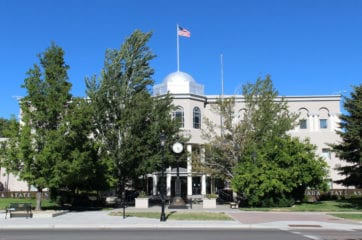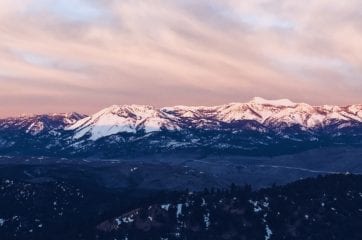Las Vegas is famous for the parts of the city that are kept cool and comfortable at all times — hotels, casinos, and restaurants. The daily reality for residents of this desert metropolis, however, especially those who are lower-income, is very different.
“During the summer, it gets ridiculously hot. Maybe the highest I’ve experienced was like 120 something [degrees],” said Surilma Mendez, who has spent the last five years living with her two young sons in what she describes as a low-income area on the East side of Las Vegas. “I feel like you could even crack an egg outside, and it will probably cook.”
In Mendez’s neighborhood, the sidewalks are broken, trash is scattered all over the ground, and the traffic is constant, she described. Even the air looks and smells dirty, but not every part of the city is like this. As a lifelong social justice advocate and experienced canvasser, Mendez often makes efforts to speak to members of the community, and she vividly recalls a conversation she had with two paleteros (the Spanish term for individuals who sell ice cream and popsicles on the street).
“They have mentioned to me that there’s a difference on the rich side, like in Henderson and Summerlin,” Mendez said. “There’s grass everywhere, there’s trees, there’s a little bit more nature.”
Even on the most oppressively hot days, outdoor workers like the paleteros have told Mendez they can’t take breaks. While it may be risky for their health, they have children to feed or medical bills to pay. During the pandemic, some of their family members have caught coronavirus, Mendez said, and they don’t have insurance and can’t collect unemployment because of their immigration status.
The paleteros aren’t the only ones who have noticed the inequities between who is subjected to the city’s high temperatures and who is not. In 2019, NPR published an investigation that found a strong correlation between income and heat in Las Vegas — the poorer areas experienced more intense heat than wealthier areas. For Las Vegas, which was identified as the country’s fastest-warming city by research organization Climate Central, that could mean serious health impacts and worsening life conditions for a vulnerable subset of the population.
Urban heat as an emerging climate risk
The way Las Vegas has been developed is a huge contributor to the heat faced by poorer communities, according to Ladd Keith, an expert in urban planning and climate change at the University of Arizona. It’s a simple equation: the more concrete and less green space, the hotter the neighborhoods. If you’ve ever walked barefoot across a parking lot on a hot day, you understand why — the pavement absorbs heat. It’s an issue some local officials see themselves.
“We have paved paradise here in Southern Nevada,” said Justin Jones, the Clark County commissioner for District F. “In a lot of the lower income areas, there is ample asphalt, but woefully insufficient tree coverage and shade structures. In some of the true urban and older areas, there is nothing.”
As climate change worsens, mounting temperatures will become harder to ignore, even for the wealthy. That’s because greenhouse gases, a large amount of which are produced from burning fossil fuels for energy, absorb heat and trap it in the Earth’s atmosphere.
There is still a lot of work to be done in addressing urban heat and its environmental justice impacts, Keith explained. Heat is insidious and invisible, unlike “media-friendly” climate impacts like wildfire and floods. Plus, in order to understand the full impacts of heat on a community, Keith explained, researchers need to know if people have access to air conditioning, whether they own a car, and what public transit they use.
“Are [residents] forced to be pedestrians and bicyclists and use transit?” Ladd said. “And during a heat event, are those modes of transportation as safe as an automobile?”
Finding solutions requires inclusion and experimentation
Ainslee Archibald lives in Summerlin, one of the Las Vegas neighborhoods Mendez described as “rich.” But Archibald, a hub coordinator for Sunrise Movement Las Vegas, understands the unjust impacts of urban heat and is working to bring a more diverse set of voices into the room where decisions are made.
“In terms of the groups and the people asked for input, it has historically been focused on very white, very conservation-based organizations,” she said. “The work I do is trying to bring more social justice concerned organizations to the conversation.”
Aside from increased inclusion in decision-making processes, Keith separates urban heat solutions into two buckets: risk management and urban greening. Risk management is people-oriented, including heat safety awareness campaigns and setting up cooling centers with shade and water. Urban greening means adding green space to cities, but also relates to the way buildings are designed. Can they be constructed with cooler materials? For cities in the dry Southwest, Keith stresses that adding green spaces needs to be balanced with conserving water. He points to Tucson, AZ, as a good example, where urban forestry has been positioned to catch natural rainfall.
For as many potential solutions as there are, Keith acknowledges that failures will have to be made in order to determine the best methods for reckoning with urban heat. Although he sees a need for increased coordination between the federal, state, and local governments, he knows there is not one silver bullet to dealing with climbing temperatures in cities. And not all the solutions will be triumphs, he said, pointing to a Los Angeles initiative where streets were covered with reflective material intended to lower air temperatures. Instead, researchers found that the material was actually increasing pedestrians’ temperatures.
“There will be experiments that don’t work and experiments that do work,” Keith said. “And I think it’s an important time to let cities experiment with these things.”



